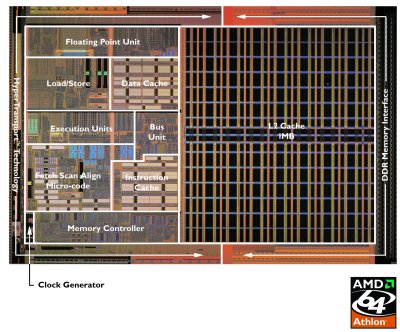AMD Athlon 64 3200+
Click to enlarge
As you can see, external appearances are very similar. The faded heatspreader of the FX-51 is on the left and the shiny, new Athlon 64 3200+ is on the right. The CAAMC is an unknown stepping currently. We'll be putting its overclocking mettle to the test in a separate section. About the only other informative bit of code relates to the date of manufacturing, which is week 30 of '03. Like a number of other AMD and Intel CPUs, the assembling is outsourced to Malaysia. In this case, the actual manufacturing is conducted in AMD's Dresden fabrication facility. The tough heatspreader is capable of withstanding a number of knocks, and it does its job of protecting the large core well. No more accidents with a Vapochill's evaporator now.
Click to enlarge
Both the AMD Athlon 64 FX-51 and AMD Athlon 64 3200+ share a similar front. The major difference, from an external perspective, is in the pin count. The FX-51 contains no less than 940 pins and is seen on the left. The Clawhammer-based 3200+ uses 'only' 754 pins. The pin arrangements are such that the Clawhammer won't fit into an Opteron / FX's socket. It's plainly obvious that the reverse is true, too.


Apart the orientation of the socket, both CPUs enjoy identical mounting mechanisms. The Clawhammer is shown on the left and the Sledgehammer on the right. AMD's reference cooler simply clips into a lug on each side and is then fastened on securely by pulling a lever down. It seems AMD is becoming more like Intel each day. We'll no doubt see an influx of Socket 754/940 coolers flood the market in the very near future.
External appearances and socket formations aside, there's actually very little architectural difference between the AMD Athlon 64 FX (Sledgehammer) and AMD Athlon 64 (Clawhammer). A look at enlarged core shots should tells us, shouldn't it ?.
Click to enlarge
If you go by the above pictures, there's no differences at all between the two, which is obviously a falsehood. The largest differentiator lies in the use of a single 64-bit memory channel for the Clawhammer (Athlon 64) and dual 64-bit memory channels for the Sledgehammer (Athlon 64 FX). Basic maths tells us that the Athlon 64, with half the memory bandwidth of the FX-series, will be hindered in memory-intensive applications, as it's only capable of digesting 3.2GB/s of bandwidth with its DDR400-compliant DRAM controller. That's where the majority of extra pins on the Opteron / FX come into play - into providing a second 64-bit memory channel. What's equally important for enthusiasts / gamers on a budget is lack of ECC L1 cache protection and ECC RAM usage. That's right, the Athlon 64 runs with a single 64-bit memory channel with regular, unbuffered RAM. Your investments in top-end Corsair, OCZ and Mushkin memory will see the light of day with the Clawhammer, but there's little need for dual channel kits. Other than this, there's precious little to separate the Athlon 64 FX and Athlon 64, save for price. Therefore, most of the information contained in our FX-51 review is pertinent to the Athlon 64 3200+. If you'd like to brush up, head over here. In short, the Athlon 64 also enjoys an on-die memory controller, albeit with a single 64-bit channel, that's geared up to work at low latencies. It also has the ability to run 64-bit code, OS permitting, and features a 1MB L2 cache with improved TLBs, SSE2 support, and SOI technology.
A little table should help in comparisons.
| CPU | AMD Athlon 64 FX51 | AMD Athlon 64 3200+ | XP3200+ Barton | Pentium 4 3.2GHz |
| Clock speed | 2200MHz | 2000MHz | 2200MHz | 3200MHz |
| L1 cache | 128kb | 128kb | 128kb | 20kb |
| L2 cache | 1024kb | 1024kb | 512kb | 512kb |
| Memory bandwidth | 6.4GB/s (DDR400) | 3.2GB/s (DDR400) | 6.4GB/s (nForce2) | 6.4GB/s (i875P) |
| FSB | 2200MHz (core speed) | 2000MHz (core speed) | 400MHz | 800MHz |
| Integer pipeline length | 12 | 12 | 10 | 20 |
| CPU Die Size | 193mm² | 193mm² ?? | 101mm² | 131mm² |
| Transistor count | 105.9 million | 105.9mm² ?? | 54 million | 55 million |
| Manufacturing process | 0.13-mircon SOI | 0.13-micron SOI | 0.13-micron | 0.13-micron |
| Memory support | ECC DDR400 DC | DDR400 SC | DDR400 DC | DDR400 DC |
| OS Support | 32/64-bit | 32/64-bit | 32-bit | 32-bit |
| Voltage | 1.55v | 1.5v | 1.65v | 1.525 - 1.55v |
| Form Factor | 940 | 754 | 462 | 478 |
A cheaper variant of the FX-51. It does away with the need for ECC memory as it's not likely to be used in mission-critical operations. The second 64-bit memory channel is omitted, giving it less bandwidth but also making it cheaper to produce. The FX-51 weighs in at around £700, and the Athlon 64 3200+, albeit 200MHz slower, is priced at almost half that. Definitely one for the enthusiast with a decent-sized budget.













